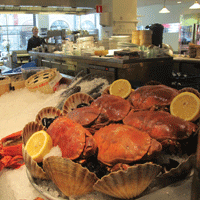Swedish chefs are returning to the country’s roots, preparing organic, local food with a reduced environmental footprint
When Patrick Tribo took over as executive chef at the Scandic Malmen Hotel in Stock-holm, Sweden he came across boxes of old menus in the basement dated from the early ’50s, when the hotel first opened. Curiously, back then, French food was the predominant menu inspiration at this quintessentially Swedish hotel.
As with much of Europe — indeed much of the world — during the first half of the 20th century, the only cuisine worthy of note came from France, and chefs went out of their way to source French ingredients and use French techniques for their preparation.
Kitchen staff were known as the saucier, commis-chef, sous-chef, pâtissier; the best food became known as Haute Cuisine or Cordon Bleu. Menus eschewed the mundane for offerings such as soupe du jour, entrecôte, petit pois and crème brûlée, and sprouted phrases such as à la minute, à la mode and table d’hôte. No cheese plate could hold its own without French cheeses — fromage anyone? Indeed, the French influence in European cuisine usually ignored local ingredients if they weren’t available in France or even rejected them as inferior.
In 1973, McDonald’s arrived in Stockholm and Swedes fell in love with the hamburger. French food began to give way to fast food. The Americans had perfected the Big Mac, crisp french fries and fast delivery. And the burger rapidly became a staple on menus the world over.
Fast forward to the new millennium and Swedish cuisine, like that of many other countries, is taking a step back in time, back to the country’s roots. So, it was fitting Tribo resurrected those old ’50s menus, taking the classic French dishes and giving them a distinctly Swedish twist. Steak frites became the Shoemaker’s Box: steak dressed with onions, red wine sauce with bacon and the mashed potatoes much beloved in Sweden, all served in a metal box. Omelettes come in the frying pan in which they are oven-baked, Swedish style. And lamb knuckles are slow cooked for the country’s traditional 36 hours and served with rotmos, a blend of root vegetables. As with many parts of the world, local cuisine and local traditions are gaining new traction.
Even the hamburger has been replaced with the distinctly Swedish Wallenbergare, a ground veal meatball served with lingonberries, mashed potatoes and peas, topped with a swoop of melted butter (Ikea serves a version of this). In fact, menus in Sweden are becoming, well, Swedish. And with that comes a host of other requirements.
“Swedes want organics today,” says Tribo. Scandic’s breakfast buffet, included with the room, offers organic and healthy choices such as crushed rye, spelt flakes, dried blueberries and goji berries. “You’ll see the logo KRAV on many things — even soap. It designates the product is certified organic, and Swedes look for it.”
Organic, local, seasonal and sustainable — these have become catchwords throughout the world. In Canada too, many chefs are making them the mantra when sourcing ingredients. And concern for the environment is part of that ethos. But for restaurateurs in Stockholm, environmental concerns are paramount and efforts such as composting, energy, waste management and seasonal cuisine have become part of the landscape.
The city is justly proud of having been awarded the first European Green Capital award in 2010. Conceived by the European Commission to recognize European cities which have achieved a high level of environmentally friendly, sustainable development, the award’s recipients serve as role models for other communities. It’s a well-deserved honour. Stockholm sits on an archipelago of 14 interconnected islands, with the waters of Lake Mälaren on one side and the Baltic Sea on the other — waters once so polluted fish were inedible. Today, fishermen line the piers where the water is safe for swimming and drinking.
Despite its rapid growth, the city has reduced greenhouse gas emissions, from 5.3 tonnes in 1990 to 3.4 tonnes today, with plans to fall below three tonnes by 2015, as measured by Kyoto standards. New communities within the city, such as Hammarby Sjostad, are focusing on eco-friendly innovations — a remarkable system of vacuum waste collection, recycling, lower-energy consumption, use of non-fossil fuels for heating and new trees to mitigate carbon dioxide production. Electric car-charging posts around the city encourage the use of more eco-friendly autos.
So, there’s a pressing need for restaurateurs to be a part of this evolution. There’s a strong move to traditional cooking methods, local and seasonal produce and to reducing waste. Clearly, these are also the goals of many restaurateurs in Canada, but, in Sweden, it’s become mandatory, says Justus Aarts, owner of Aarts Mat och Dryck (Aarts Food and Drink) in Stockholm’s Sofo district. “Swedes really care about what they eat. They are into organics, and, while the food obviously has to taste good, they will choose a restaurant that cares about the environment.”
The menu at Aarts is very small and the dishes are mostly organic and seasonal — stretched with traditional methods such as pickling and preserving. The menu in the fall featured an appetizer of smoked beets with local goat cheese, pea liquor, croutons and local honey or a main course of char with cucumbers in vinaigrette, pea purée and cider vinegar foam. This small restaurant collects its green waste for pick-up twice a week for conversion to bio-gas. Because space is limited, says Aarts, “It forces us to keep waste down as we don’t have much storage room.” They produce, just two bags a week of material that can’t be recycled or composted.
Pontus Frithiof, probably Sweden’s most celebrated chef (his poster-sized photo greets visitors at the airport), trained in Paris and Brussels. But his restaurants, Pontus and Pontus by The Sea, are refocusing attention on Swedish cuisine. Here too, kitchen waste is collected to make bio-gas, and the electricity is green sourced. About 50 per cent of his ingredients are organic. “But the first consideration is freshness and flavour,” he says. “If it has to come from Spain to be organic, I’ll buy local Swedish first.”
The menu clearly has multicultural elements — Thai fishcakes, sashimi, gazpacho, pata negra (Iberian ham) and more. It’s a concession to the widely travelled population of Stockholm. There’s even a Pontus 200g burger with bacon and cheese, and another Pontus signature dish is deboned poussin (young chicken) stuffed with truffled foie gras mousse — a nod to French cuisine. But simple dishes such as chanterelles in season, sautéed in butter and served on crisped toast points, or fried Baltic herring with mature Västerbotten cheese are classic Swedish fare. And, because they buy whole animals, from the farmer (butchered locally, as the Pontus kitchen is too small), they use the ovens during the night for slow simmering traditional dishes such as lamb stew.
Home-cooked food seems to be what busy Swedes want. Urban Deli, a food store and restaurant in Stockholm, has made an enormous success of home-made fare. It began because, in true Swedish fashion, they wanted to reduce waste in the food store. But the restaurant and home-meal replacement part of the business has blossomed in the last two years. “It’s affordable, mostly organic, and contains no additives,” says Jesper Konstantinov, manager. “It’s as close to home cooking as you can get, but it’s ready made.” Dishes such as pork cheeks with seasonal mushrooms and bacon potato purée; fish stew laden with the bounty of the ocean; or game stew with lingonberries are locally inspired and hugely popular.
Game is another part of traditional Swedish cuisine that has seen a significant revival in recent years. In the north, the Sami people herd reindeer, and every fall the animals are culled. Reindeer meat, both fresh and as charcuterie, can be found in restaurants, food stores and the city’s open-air markets. Fem Små Hus (Five small houses) in Stockholm’s Old Town has made a specialty of tender reindeer steak, served with a rich lingonberry sauce, root vegetables and the ubiquitous mashed potatoes encased in pastry. Despite an extensive menu, on any given night, more than half the orders are for reindeer steak, says Maj Uddenfelt, maître d’hôtel.
Remember the French cheese plate? Today, fromage has been replaced by ost, and while Swedish cheeses are more expensive than those from France, you might find the plate features Prästost, a nippy cow’s milk cheese (“Priest cheese” that gets its name from Sweden’s old custom of paying tithes to the church) or Brodsjö Blå, a flavourful sheep’s milk blue cheese. This not only supports local industry, it reduces the food miles of the restaurant’s offerings.
Patrick Tribo applauds the move back to traditional, slow-cooked cuisine. “They are out there eating hamburgers, and forgetting how to cook traditional food,” he comments wryly. “That’s OK, they’re going to need chefs like me to cook those traditional dishes, and my job is safe for many years to come.”
As they say in France, “Plus ça change, plus c’est la même chose” — the more things change, the more they remain the same.
Features:
Forward Thinking for Foodservice Operators
The Sizzle of Success: Burgers and Fries
Interested in Purchasing a Franchise?
Clean Sweep: Kitchen Sanitation
Open for Business: Latest Foodservice Must-Haves
Changing of the Guard: Icewine
Tall Order: Profiling Chef Marc St. Jacques





















